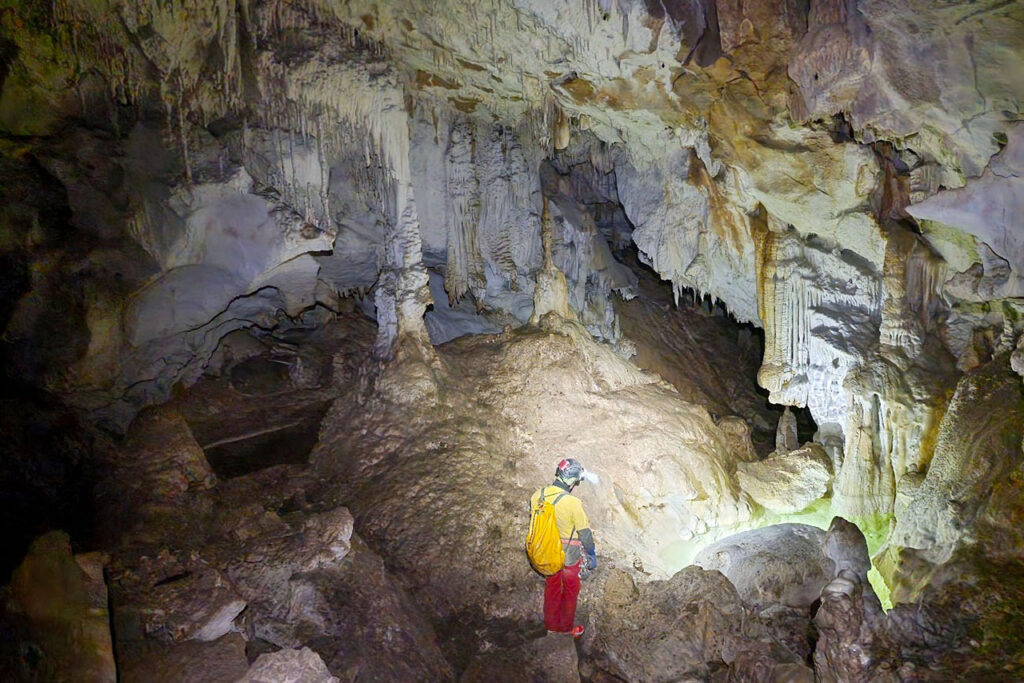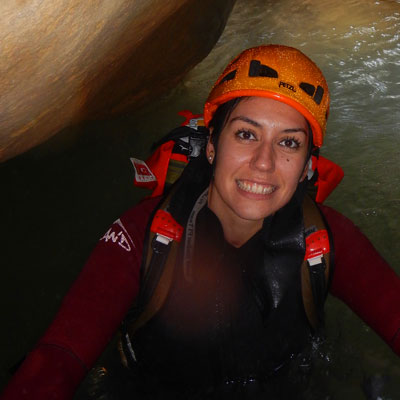Necessary equipment for caving. Part 1: Clothing and footwear.

Outer suit, inner suit, pontoon, neoprene, booties, boots, helmet, headgear, harness, descender... As you can see, there are quite a few things that make up the caving equipment and maybe you don't even know where to start, but don't worry, you're in the right place. Read on and discover one by one the basics that you can't miss in your caving equipment.
The caving team:
Modern caving has evolved a lot in terms of technique and equipment, and the fantastic caving equipment that we now have at our disposal in specialised shops has nothing to do with the equipment used by cavers in past centuries.
In fact, the evolution of caving equipment is one of the main reasons why we can now take on greater challenges than our ancestors, explore deeper caves, better withstand the climatic conditions inside caves or study and topograph large cavities.
How important is the equipment we use in our mountaineering activities? In my opinion, it is everything! Being well equipped in the mountains and knowing how to use the equipment correctly is a "guarantee of success" in our activities.
As I said at the beginning, caving equipment is very wide and gives a lot to talk about, that's why in this first article we will focus on clothing and footwear and in the next one, on the progression and safety equipmentWill you join me to find out?
Cordura or polyester/cotton outer suit:
The outer coverall serves to protect us from chafing and bumps against the rock, and from the cold and water that can fall into the shafts as we progress.
They are mainly of two types (more on these later):
- Polyester or cotton coverallsThe type used by mechanics. We use this type of coveralls when we do fossil caves with pleasant temperatures that do not go below 13 or 14 degrees Celsius.
- Breathable and non-breathable cordura coveralls: we use them in somewhat colder caves, such as those in the Pyrenees or the Cantabrian Mountains.
- This type of coverall is made of a nylon that is highly resistant to abrasion and tearing. The non-breathable ones have a PVC coating on the inside.
- It has protections on the knees, buttocks, elbows and some models have a hood for descending down wells.
- Collar with fleece lining and velcro fastening. Usually elasticated at the waist and gusset at the back for greater comfort.
- They also usually have a small chest pocket and adjustable cuffs.

Recommendation:
Personally I recommend the brand Aventure Verticale, they are hard, comfortable and have very good durability, ideal for many types of caves.
Instead of cordura or cotton overalls we use:
- PVC overall: to explore very cold caves or well-watered holes where we are likely to be constantly wet without swimming.
- Neoprene: recommended when the progression is by river, either swimming or on foot. They are available in different thicknesses and compositions.
- Ponto: is a latex bib and brace that guarantees almost total waterproofing for progression along rivers or watered wells.
- Dry suit: it is a single piece, ideal for very aquatic crossings, or very aquatic sections and very cold cavities. Composed of latex, nylon, tricot. Waterproof, completely watertight from head to toe.
Indoor coverall:
It is not enough to just wear an outer suit, we must not forget that even if we do fossil caves, sometimes we have to crawl or go down watered wells, and the water will gradually soak into our outer suit. For this reason, and because the temperature in the cave can sometimes be quite cold, it will also be necessary to equip yourself with an inner suit underneath your cordura suit.
For Pyrenean caves it would be advisable that the inner suit has polartec, as they are the warmest in these conditions of low temperatures.
For caves with temperatures of 13 to 18 degrees Celsius, we can wear a thinner coverall.

Characteristics to take into account when choosing an overall:
- It would be advisable to have bi-elastic fabric and fits snugly to the skinto reduce body heat loss.
- Quick-drying fabric.
- Some have zip which makes it easier not to have to take it off when you have to go to the toilet.
PVC coverall:
We are talking about one-piece PVC coveralls, not breathable but ideal for exploration in very cold or Pyrenean caves, or even for occasional caves with watered wells where, as we know, we are likely to get constantly wet without swimming.

Ponto:
If we want to dispense with the PVC coverall and we think that our use will be rather occasional, the MTDE pontoon, made of latex, guarantees an almost total waterproofing in river progression or in the ascent of watered wells.
No seams, no welding. Easily slips over underwear. Significantly limits calorie loss during prolonged aquatic progressions.
Dry suit:
In recent years we have seen an increase in the practice of activities that until now were only carried out in the spring-summer months and this is also thanks to the new equipment that is evolving.
The dry suit allows us to do very aquatic caves or canyons in winter and to finish dry after the activity. Underneath the dry suit we will wear an under suit or thermal underwear.
It consists of an outer fabric, a breathable and waterproof inner membrane and a tricot inner fabric.
The suit is completely watertight, the seams are thermosealed, latex collar and cuffs and breathable socks. It should be treated with great care as the slightest rubbing will cause it to lose its watertightness.
Footwear:
For fossil cavities and little or no water, it is more advisable to use hiking boots, preferably with Gore-Tex, and good grip or vibram soles (an abrasion resistant rubber sole).
For very aquatic caves you can use from canyoning boots (Adidas TerrexHydro Lace) to the mythical water boots of all times, but you must have a good grip.
The waterproof boot, like the watertight canyoning boots, in very watery or muddy caves, heats the water inside and as it does not drain, our feet do not get so cold. It is also very quick to clean.

Socks or socks:
In water caves we have several options:
- BootiesThey will protect us from the cold water. They are made of neoprene and nylon. They come in different sizes and thicknesses, and ideally do not have soles.
- Latex sockswaterproof to 100% up to 40 cm of immersion, and also avoid any heavy water reserves. For example, those from MTDE.
In more fossiliferous caves, not very watery or somewhat watery and very cold, I recommend the LORPEN, TREKKING EXP.POLARTEC OVERCALF. socks, excellent polartec socks for cold expeditions.
GLOVES:
Essential in our underground equipment. Gloves protect us from rubbing, mud and rope burns, especially when the ropes are dry.
For very aquatic and cold caves, we recommend neoprene (3 to 5mm thick), or also PVC gardening type, which are high.
For fossil caves or caves that are not so cold, hardware store caves with fine stretchable mesh and rubber protection may be suitable.
You may be interested in:

Headlamp, helmet, harness, anchor line... discover the safety and progression elements that are a must in your caving equipment.
Fastpacking is not about going faster. It's about going lighter.
If you come from classic trekking, this is the next step: learning to move with less weight,
more fluid and enjoying every kilometre more.
Join the channel and start discovering what lightness feels like.






